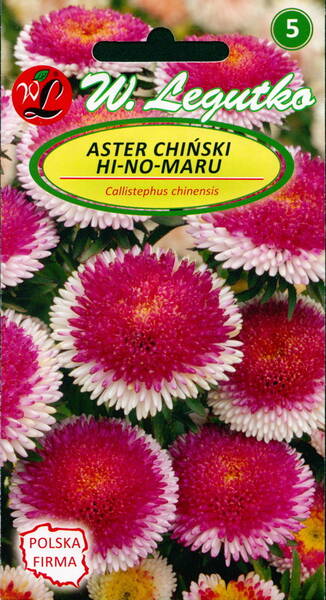Two-color pompom aster up to 50 cm high.

* From gorgeous asters grown in your own garden, you want to collect seeds so as not to part with your favorite flowers. However, an attempt to obtain seeds from some asters is sometimes unsuccessful - when looking for a reason, it makes sense to study the biological characteristics of the aster culture.
The inflorescence-basket of aster consists of reed, located along the edge, and small tubular flowers in the center, between which flowers of the transitional type are located in 1-2 rows. Small tubular flowers are bisexual, and reed and transitional are unisexual female.
Annual asters are capable of self-pollination and cross-pollination. Tubular flowers are pollinated by their own pollen, and ligulate and transitional ones are cross-pollinated by insects (pollen from tubular flowers of their own or another inflorescence). Ornamental varieties of asters have double inflorescences, consisting of reed or long tubular flowers, in which small yellow tubular flowers are almost absent (or not visible). With an increase in the doubleness of the inflorescences, their pollination becomes more difficult and the duration of the flowering of asters increases (small tubular flowers live for about 1 week, and reed flowers - 2-7 weeks). After pollination, tubular flowers wilt, and reed flowers remain decorative until all tubular flowers are pollinated.
Among the variety of asters varieties, high-yielding ones stand out - giving a large number of seeds, and low-productive ones - producing few seeds (these are, as a rule, the most decorative asters). The less the doubleness of aster inflorescences, the more seeds are formed and the faster they ripen. The higher the doubleness of aster inflorescences, the fewer small tubular flowers, respectively, and less seeds are tied (in inflorescences consisting only of reed flowers, the seeds are practically not tied). To preserve the terry asters, it is necessary to collect seeds from the most terry inflorescences - terry inflorescences will not be obtained from seeds from less terry baskets in the future.
In regions with a long spring and cold autumn, soil and winter asters almost never manage to get seeds, because they bloom half a month later and bloom a month longer than asters grown in seedlings - the seeds do not have time to ripen before the autumn cold (asters bloom in 80-125 days after germination, and seed ripening occurs in 150-183 days).
For an earlier flowering of asters in July and early August, it is necessary to sow seeds for seedlings in the second half of March and early April. In addition to extending the growing season, the amount of positive temperatures received by plants during the season is important, therefore, asters are more successfully grown for seeds in regions with a warm climate, where warm spring and long dry autumn allow to complete the full cycle of plant development. At the same time, during the period of seed ripening, it is important to maintain the soil moisture necessary for asters - this also affects productivity. High quality aster seeds can be obtained only from strong healthy plants, free from pests and diseases, therefore, when growing seed asters, it is necessary to strictly observe the agrotechnology of aster culture and their crop rotation (return the planting of asters to their original place no earlier than in 4-5 years) ... Multi-tiered branching of aster shoots slows down the formation and maturation of seeds, therefore it is necessary to leave the first and best 3-6 inflorescences on the mother plant (depending on the variety, and in later varieties 1 inflorescence), and remove the rest.
Seeds of asters of various varieties ripen approximately 40-60 days after the beginning of flowering (depending on weather conditions, the duration of flowering of asters changes and the ripening period of seeds is shifted). Dry baskets with ripe seeds are harvested in sunny, dry weather. If, before the frost, the seeds on the aster bushes have not yet fully ripened, then the bushes are transplanted into pots (asters easily tolerate a neat transplant), which are transferred to a dry, light room for growing and ripening. It takes about 15-20 days to ripen inflorescences with completely dried ligulate flowers with good air exchange and a temperature of 15-20 degrees.
When ripening, it is necessary to turn the plants from time to time for uniform illumination and airing of the inflorescences. After ripening, the seeds are cleaned of plant residues, poured into hermetically sealed glass vessels, which are stored at low humidity and a temperature of about 2 degrees (otherwise the seeds will lose their germination rather quickly). Subject to optimal storage conditions, high quality aster seeds remain viable for 3 years.












